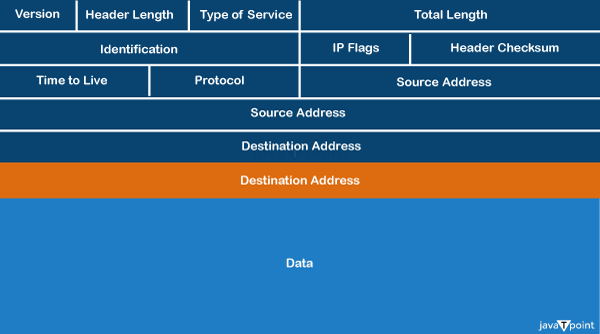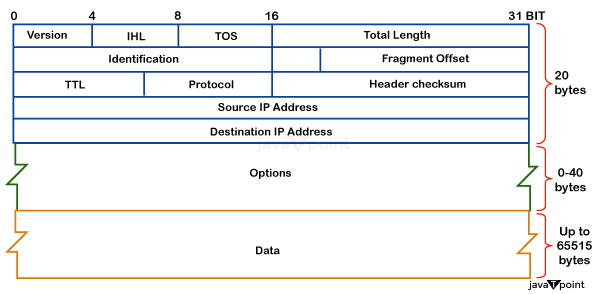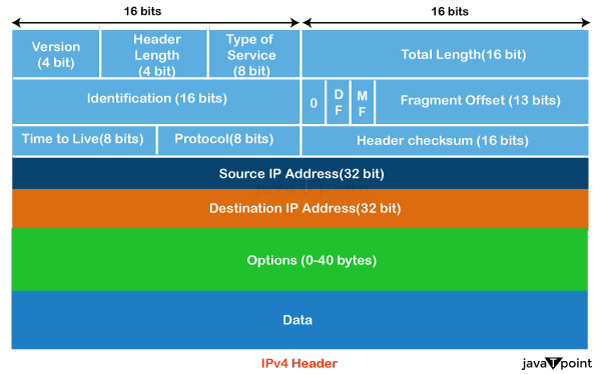ipv4 Headers
Internet Protocol version 4, or IPv4, is a basic communication protocol that makes data transfer between networked devices easier. The IPv4 header, a vital component that encapsulates critical information for routing and delivery, is at the centre of IPv4 communication. The source and destination IP addresses, protocol version, time-to-live (TTL), and checksum are among the numerous fields that make up the IPv4 header. To ensure correct routing and delivery of data packets to their intended destination, these fields are essential for directing them through the network of routers. The IPv4 header, a crucial component of the packet structure, acts as a road map for dependable and effective data transfer, facilitating the smooth operation of the international Internet. The informational blueprint guiding the transmission of data packets across networks is contained in IPv4 headers. The IPv4 header, consisting of several fields, contains information essential for routing and delivery. The source and destination IP addresses, which specify the start and finish of the data transfer, are two of its essential parts. Furthermore, the time-to-live (TTL) field helps prevent infinite loops by establishing a limit on the packet's lifespan, and the protocol version field identifies the version of the Internet Protocol that is currently in use. The checksum verifies that the data received has not been tampered with during transmission, ensuring the integrity of the header. The IPv4 header facilitates data packet navigation through the complex network infrastructure by giving these necessary parameters, guaranteeing accurate, efficient, and secure communication between devices linked to the global Internet. ipv4 Headers
An essential part of the Internet Protocol version 4 (IPv4) family, the IPv4 header describes the format of data packets sent via IP networks. Each of the several fields that make up the IPv4 header has a distinct function that helps with data delivery and routing. IPv4 header fieldsThe IPv4 header fields are broken down into depth below:
1. Version (4 bits): Denotes the IP protocol version; IPv4 is denoted by the binary number 0100. 2. Header Length (4 bits): Indicates how many 32-bit words make up the IPv4 header. This element is essential for determining where the data payload begins. If extra fields (such as options and padding) are present, then additional 32-bit words are added to the minimum value (5), which denotes a 20-byte header length. 3. Service Type (8 bits): This field is frequently used for Differentiated Services Code Point (DSCP) and Explicit, while it was initially intended for Quality of Service (QoS) settings and Explicit Congestion Notification (ECN) markings. Explicit Congestion Notification (ECN) and Differentiated Services Code Point (DSCP) designations, which were initially intended for Quality of Service (QoS) settings, are now frequently included in this field. ECN enables routers to notify endpoints of congestion, whereas DSCP establishes the packet's priority and class of service. 4. Total Length (16 bits): Indicates the IPv4 packet's overall size, considering the header and data payload. 5. Identification (16 bits): A distinct identifier is assigned to every fragment of a fragmented packet to facilitate reassembly at the destination. 6. Flags (3 bits): The three-bit flags "Reserved," "Don't Fragment (DF)," and "More Fragments (MF)" are included. These are employed in the processes of packet reassembly and fragmentation. 7. Fragment Offset (13 bits): Enables proper reassembly by indicating where the data fragment is in the original packet. 8. Time-to-Live (TTL, 8 bits): Indicates how many hops (routers) a packet can go through before being dropped. Reduced by one for every jump to avoid endless loops. 9. Protocol (8 bits): Indicates the protocol (such as TCP) used in the data payload, such as TCP, UDP, or ICMP. 10. Header Checksum (16 bits): Guards against corruption during transmission by authenticating the contents of the header and ensuring its integrity. 11. Source IP Address (32 bits): The sender's IP address is specified by the source IP address (32 bits). 12. Destination IP Address (32 bits): The IP address of the intended receiver is indicated by the destination IP address (32 bits). 13. Variable length options: An optional and infrequently used field that may contain several factors, including record route, timestamp, and others. 14. Padding (variable Length): When optional fields are provided, padding (varying Length) ensures the header terminates on a 32-bit boundary. In conclusion, the IPv4 header is an organised collection of fields that offers the data required for packet delivery and routing over IP networks. Every field has a distinct function in guaranteeing the packet's integrity, appropriate management, and effective transmission through the network. ExampleTo demonstrate how the header fields work, let's look at an actual IPv4 packet example: 
To request a webpage, your computer (Source IP: 192.168.1.2) needs to contact a web server (Destination IP: 203.0.113.5). TCP is the transport protocol that the computer uses to guarantee dependable communication.
This example highlights the functions of the several IPv4 header fields in enabling dependable data transfer between devices on an IP network by showing how they are filled in for a particular communication scenario. ConclusionIn summary, we have covered the main features of the IPv4 header, which is an important part of the Internet Protocol version 4 (IPv4) suite. Each of the several fields in the IPv4 header has a distinct function that helps direct the delivery and routing of data packets across networks. Time-to-live for hop limitation, protocol for identifying the payload protocol, checksum for header integrity verification, source/destination IP addresses for routing, version and header Length for protocol identification and structure, type of service for Quality of Service markings, total Length for packet size, identification for fragmented packet reassembly, flags for control in packet fragmentation, fragment offset for proper reassembly, and so on are some of these fields. Each field is essential to guarantee the correct operation, integrity, and effective transfer of data packets across the Internet. The design of the IPv4 header tackles important networking issues, including quality of service, error detection, and fragmentation, helping to ensure dependable and consistent communication that serves as the cornerstone of the world's network infrastructure. Network administrators, engineers, and anybody else engaged in computer network configuration, upkeep, and troubleshooting must comprehend the specifics of the IPv4 header. |
 For Videos Join Our Youtube Channel: Join Now
For Videos Join Our Youtube Channel: Join Now
Feedback
- Send your Feedback to [email protected]
Help Others, Please Share









